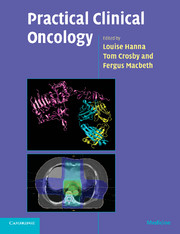Book contents
- Frontmatter
- Contents
- List of contributors
- Preface
- Acknowledgements
- Abbreviations
- 1 Practical issues in cytotoxic chemotherapy usage
- 2 Biological treatments in cancer
- 3 Hormones in cancer
- 4 Radiotherapy planning
- 5 Research in cancer
- 6 Oncological emergencies
- 7 Palliative care
- 8 Head and neck
- 9 Oesophagus
- 10 Stomach
- 11 Liver, gallbladder and biliary tract
- 12 Exocrine pancreas
- 13 Colon and rectum
- 14 Anus
- 15 Gastrointestinal stromal tumours
- 16 Breast
- 17 Kidney
- 18 Bladder
- 19 Prostate
- 20 Testis
- 21 Penis
- 22 Ovary
- 23 Body of the uterus
- 24 Cervix
- 25 Vagina
- 26 Vulva
- 27 Gestational trophoblast tumours
- 28 Lung
- 29 Mesothelioma
- 30 Soft tissue and bone tumours in adults
- 31 The lymphomas and myeloma
- 32 Central nervous system
- 33 Skin cancer other than melanoma
- 34 Melanoma
- 35 Thyroid
- 36 Neuroendocrine tumours
- 37 Cancer in children
- 38 Cancer of unknown primary
- 39 The use of radiotherapy in the treatment of benign conditions
- Multiple choice questions
- Multiple choice answers
- Index
- References
7 - Palliative care
Published online by Cambridge University Press: 23 December 2009
- Frontmatter
- Contents
- List of contributors
- Preface
- Acknowledgements
- Abbreviations
- 1 Practical issues in cytotoxic chemotherapy usage
- 2 Biological treatments in cancer
- 3 Hormones in cancer
- 4 Radiotherapy planning
- 5 Research in cancer
- 6 Oncological emergencies
- 7 Palliative care
- 8 Head and neck
- 9 Oesophagus
- 10 Stomach
- 11 Liver, gallbladder and biliary tract
- 12 Exocrine pancreas
- 13 Colon and rectum
- 14 Anus
- 15 Gastrointestinal stromal tumours
- 16 Breast
- 17 Kidney
- 18 Bladder
- 19 Prostate
- 20 Testis
- 21 Penis
- 22 Ovary
- 23 Body of the uterus
- 24 Cervix
- 25 Vagina
- 26 Vulva
- 27 Gestational trophoblast tumours
- 28 Lung
- 29 Mesothelioma
- 30 Soft tissue and bone tumours in adults
- 31 The lymphomas and myeloma
- 32 Central nervous system
- 33 Skin cancer other than melanoma
- 34 Melanoma
- 35 Thyroid
- 36 Neuroendocrine tumours
- 37 Cancer in children
- 38 Cancer of unknown primary
- 39 The use of radiotherapy in the treatment of benign conditions
- Multiple choice questions
- Multiple choice answers
- Index
- References
Summary
Introduction
Changing role of palliative care in oncology
The World Health Organisation (WHO) defines palliative care as ‘the active total care of patients whose disease is not responsive to curative treatment, where control of pain, of other symptoms and of psychological, social and spiritual problems is paramount with the achievement of the best possible quality of life for patients and their families as the goal’ (World Health Organisation, 1990). Palliative care should now be considered an integral part of service planning and care delivery in oncology.
This chapter covers common problems in symptom control, communication, ethical decision making, and the financial difficulties of patients with advanced cancer.
Changing model of palliative care
In the old model of the cancer journey (Figure 7.1(a)), palliative care services would only be involved at the end of life when no further oncological or supportive treatments were available. This was a ‘terminal care’ service for those clearly at the end of life. But, the symptoms that were being controlled occur not only at the end of life but also at different degrees throughout the cancer journey. The new model (Figure 7.1(b)) attempts to dovetail palliative care with active treatment, gradually increasing its involvement as active treatment becomes less appropriate. Some patients, such as those with carcinoma of the pancreas, are likely to need palliative care input early in their illness.
Pain control
Pain is an unpleasant sensory and emotional experience associated with actual or potential tissue damage.
- Type
- Chapter
- Information
- Practical Clinical Oncology , pp. 83 - 92Publisher: Cambridge University PressPrint publication year: 2008



